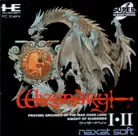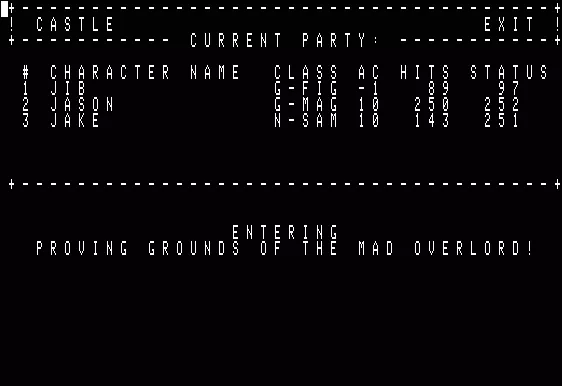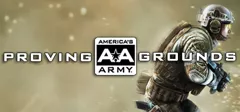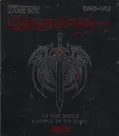Wizardry: Proving Grounds of the Mad Overlord
-
 Wizardry: Proving Grounds of the Mad Overlord
(2023 on
Windows)
Wizardry: Proving Grounds of the Mad Overlord
(2023 on
Windows)
Description official descriptions
The Mad Overlord Trebor was once only power-mad, but went off the deep end after he acquired a magical amulet of immense power, only to have it stolen from him by his nemesis, the evil archmage Werdna. Werdna, not quite sure how to use the amulet properly, accidentally causes an earthquake which creates a ten-level dungeon beneath Trebor's castle. To avoid looking silly, Werdna declares the dungeon to be the new lair for him and his monster hordes. Trebor, not to be outdone, declares the labyrinth his new Proving Grounds where adventurers must prove themselves for membership in his elite honor guard, and incidentally retrieve his amulet in the process.
The first Wizardry was one of the original dungeon-crawling role-playing games, and stands along with Ultima and Might & Magic as one of the defining staples of the genre.
The player generates and controls a party of up to six different adventurers, choosing from five races (humans, elves, dwarves, gnomes and hobbits), three alignments (good, neutral and evil), and four basic classes (fighter, priest, mage and thief). These can later evolve into elite classes (bishop: priest with mage spells; samurai: fighter with mage spells; lord: fighter with priest spells, and ninja: fighter with thief abilities) if they meet the necessary level requirements. After outfitting the party with basic weapons and armor, the player sends it into a 3D vector maze-like dungeon to fight monsters in turn-based combat and find treasure.
Spellings
- ウィザードリィ 狂王の試練場 - Japanese spelling
Groups +
- Fantasy creatures: Dragons
- Fantasy creatures: Dwarves
- Fantasy creatures: Elves
- Fantasy creatures: Gnomes
- Fantasy creatures: Halflings / Hobbits
- Fantasy creatures: Orcs
- Fantasy creatures: Trolls
- Gameplay feature: Character development - Automatic leveling
- Games made into books
- Genre: Dungeon Crawler
- Wizardry games
Screenshots
Promos
Credits (Apple II version)
5 People
| By |
|
| Illustrations |
|
| Playtesting |
Reviews
Critics
Average score: 59% (based on 5 ratings)
Players
Average score: 3.6 out of 5 (based on 108 ratings with 5 reviews)
One of the *great* original dungeon-crawlers!
The Good
It was the first computer game that I ever saw that attempted to graphically render the D&D game. There may have been others out there that I was unaware of, but for me, it was ground-breaking.
Where to start? Character creation like D&D. Random numbers for wisdom, strength, dexterity, constitution, intelligence. Pick a class, pick evil good or neutral. Buy armor for the front three guys and go down in the dungeon to kill monsters and gather treasure!
It doesn't get any better than that! (well it does, but it didn't in 1985). So over the course of weeks or months you built your characters up (and sometimes they would change from good to evil - forcing you to start over with a new priest or mage). But eventually you would get to the final showdown with Werdna! ...and he would kill everyone in the party. After several tries though, you could kill him. And that was the coolest thing in the world!
The Bad
Characters changed alignment occasionally when they leveled up, and sometimes you would have to start a new character up in the needed alignment to match the rest of the party.
Another thing I disliked was having to type out the exact text of the spell I needed my mage or priest to cast. In excitement or in the wee hours of the morning, I occasionally misspelled a word, so no spell was cast. A bummer when one of the other characters desperately needed healed, or I needed to cast a massive damaging spell.
The Bottom Line
D&D without the dice or graph paper.
PC Booter · by ex_navynuke! (42) · 2005
Landmark RPG in computer gaming
The Good
This is the first computer role playing game I ever purchased. Actually, one of the main reasons I pestered my parents into buying me an Apple II was so I could play this game. It cost me $50 in 1983, which is over $90 today. The disk drives that came with my second-hand Apple weren't up to reading the sensitive Wizardry disks, so I had to get them repaired first.
But all the headache was worth it. I was a big D&D fan, but living up in the sticks, I rarely had anyone nearby to play with. This game was a great solution to this problem. Not only was I amazed by the flashy opening animation, I was enthralled by the gameplay. While the graphics were crude and splotchy by today's standards, they amazed me in 1983! There was a graphic representation of the actual monster I was fighting! Right there in front of me! Of course it was static--it wasn't animated--but I didn't have to remember what it looked like. There it was! I was fighting an orc! A skeleton! A slime! Woo-hoo!
And for the first time, I could actually see the dungeon from the point of view of my characters! The dungeons were rendered as crude line drawings, but in the 1980s, that was state of the art! Not even the staircases were rendered, but that didn't matter. There were the walls in blotchy Apple II "white." How could it get any better?
Though it wasn't strictly D&D, it was close enough for my tastes. Though it was just one dungeon, it was enough to satisfy my desire to role-play.
Wizardry allowed to user to carefully orchestrate his party's attack, just like all early paper role-playing games. And the party could consist of several adventurers of different classes (mages, fighters, clerics, etc.). Where in D&D I had to role all my own dice, the computer now took care of it for me, showing me my virtual "roll" versus the enemy's. While sometimes I groaned over the result, I couldn't argue that it wasn't fair. After all, it displayed my result, right there in front of me.
While I never finished this game, it gave me endless pleasure in role-playing alone or impressing envious friends.
While it was far outdone by later games (notably The Bard's Tale), Wizardry launched the genre and remains one of the most important computer role-playing games in the history of video gaming.
The Bad
Wizardry, like many early home computer games, was pretty unforgiving to the user. The player could only have one active game, and there was no way to prevent your party from getting killed when outmatched in a fight, or to back up and retry a battle. Once your party got killed, they really got killed! And the game was pretty merciless about saving the data to disk. If you pulled out the disk so it couldn't save the information that your party got killed (as I did on many occasions), there was a good chance that your copy of the game would become corrupted. Even though they warned not to remove the disk, I and many other players did, so as not to lose scores of hours of adventuring. The only way to recover the disk was to mail it back to Sir-Tech for repairs.
The Bottom Line
A great landmark computer RPG. Outdone by successors, but unmatched when it came out. Worth a look for any video game aficionado.
Apple II · by Frecklefoot (188) · 2007
Many improvements are overshadowed by new bugs
The Good
Wizardry on the NES was released after Dragon Quest/Warrior, which borrowed many ideas. Dragon Quest set expectations for console RPGs that Wizardry, as it was released on the Apple II, would not meet.
Many changes made to the NES version are improvements. Enemies are much more detail and the walls are solid (as opposed to a wireframe). There's even music, and it's actually a little catchy.
The battle system has been streamlined for the NES's controller. Menus are now selected using an arrow cursor and spells are listed (as opposed to having to type them out to cast them).
The Bad
The NES version, however, introduced a number of bugs. The most significant is that AC,apparently, does nothing. This makes the game a lot more difficult, though that difficulty is offset by the easy of hitting the reset button on the console and abusing Wizardry's autosave feature.
The NES version also removed many puzzles that were present in computer versions. This was because they usually required text entry, though replacements for these would have been a welcome change to dungeon crawling.
One problem that Wizardry has in general is accessibility with its spells. To new users, the seemingly jibberish names for spells mean nothing. Without a manual, there is no way to know that dios heals wounds and malor can kill you instantly if you don't enter coordinates correctly. This sort of trial and error is very unfair, especially for the more dangerous spells like haman and malor that can has permanent consequences.
The Bottom Line
Wizardry is a simple game, with a simple goal--get to the bottom of the dungeon. The key to success isn't your ability to grind and gain levels--it's your ability and patience to map each floor in detail.
Mapping is something that may put off many users, but it is the key to what makes Wizardry the adventure that it is. The constant fear of getting lost, the dread of walking through a door and having it vanish behind you--the act of mapping is what connects the player to the adventure. As the party transverses the blackness of the dungeon, the constant unknown created by mapping engages the player in a unique dimension.
The is really what still makes Wizardry unique and worthwhile today. It isn't just one of the first RPGs, it's still an experience that many games that followed could not reproduce.
NES · by Scribblemacher (195) · 2012
Discussion
| Subject | By | Date |
|---|---|---|
| Why a dragon on the cover? | Scribblemacher (195) | Sep 6th, 2012 |
| how to use flopper and activate a scenario disk | unit | Aug 3rd, 2007 |
Trivia
Andrew Greenberg, Inc. vs Sir-tech Software, Inc.
Back in 1979 Andrew Greenberg, Inc. created the name, concept and plot for a computer fantasy role-playing game "Dungeons of Despair", released two years later by Sir-tech Software, Inc. as "Wizardry". Both corporations entered into an agreement granting Siro-tec the right to manufacture and market Wizardry, related products and any subsequent versions of the game in exchange of a payment of license royalty fee and a percentage of gross sales revenues. However, after success of the first Wizardry game release, Sir-Tech stopped sending royalty payments and accounting statements to Andrew Greenberg, Inc.
In 1992 Andrew Greenberg, Inc. sued Sir-tech Software, Inc for not paying royality fee, breach of contract, trade secret misappropriation and tortious interference, starting a long term (3 decades) lawsuit, resolved after Sir-tech bankruptcy.
Bugs
There is a famous bug in Wizardry that gives players a large number of experience points if you type an item number that's not on the numbered list when having your party's bishop identify them. When the PC version finally arrived years after the Apple II release, the programmers intentionally left the bug in to be "fair" to PC players.
The NES version of the game features a bug involving the Armor Class statistic. While the characters can change their armor class by equipping different items and the character screen reflects it, the statistic is not used in combat calculations.
Code
Wizardry is written in Pascal. Several instances of code appear sprinkled throughout the diskette (they probably mastered it on a diskette they had not fully erased). For example:
```
BEGIN MoveLeft(S^.Dat a,Info,1+Ord(S^.Data[0])); Exit(GetStr) END; blk:=KN DIV 256+SoffSet; offset:=2(KN MOD 256); C:=CheckCache(dHead,dTail,blk); (strOffsets^[strTree^[lastTree].iindexOffset+[lastTree].startIndex]); Info:='ERR*' END;
PROCEDURE PlotStr; VAR S:Str255; BEGIN
FOR i:=0 TO numInParty-1 DO
BEGIN
BigAdd(totGold,Party[i].Gold); Party[i].Gold:=noGold; END;
Party[N].Gold:=totGold END;
```
Development
According to Andrew Greenberg, the prototype Wizardry was created because of a challenge Greenberg accepted at college to create a computerized version of D&D. He later teamed up with Robert Woodhead to improve the game for commercial release.
Extras
The PC version of Wizardry came out three years after the original Apple version, and those three years gave wisdom to Sir-Tech. Users of the original PC version were treated to the following (extensive!) materials:
- Player's Guide (manual)
- Playing Wizardry On Your IBM PC & PCjr (PC-specific guide)
- Instructions and Briefing Materials (an overview of the story)
- A notice on backing up your master disk to a scenario disk
- A note from the authors asking that the user not use "cheat programs"
- Tips on Keeping Your Computer Healthy
- Map Plotting Aid
Notes:
- The "map plotting aid" was a small pad of graph paper--with the first page printed as a partial map of level 1 to get you started!
- The Tips on Keeping Your Computer Healthy were presumably added to help keep generic PC support calls to a minimum. (Back in 1984, there weren't many places to turn to for tech support.)
- The special note from Andrew and Robert was not to politely ask the user not to copy the software illegally, but instead asked that the user not use cheat codes to ruin the playing experience!
The Tips on Computer Care and the Note to Users are reproduced below for historical significance:
<hr />Tips on Keeping Your Computer Healthy
We hope you are getting a byte or two out of your computer each day. Here are a few tips on prolonging the life of your software.
Clean Your Disk Drives
Cleaning your disk drives takes only a few minutes and makes them work better. Clean your drives every second week.
Get Your Drives Tuned
A majority of disk problems are caused by misaligned disk drives. Your most valued software could be damaged. So protect your investment—get your drives aligned and speed adjusted at least twice a year at your dealer.
Protect Your Computer’s Power
Computers like a steady power supply. However, large appliances or equipment send spikes down a power line. These power spikes cause memory glitches and can alter software if you were writing to the disk when a transient happened. A surge suppressor such as a Blitz Bug will prevent power surges. At $25 to $50, they are a good investment.
Follow these tips and you will probably never have a problem with your software. Our experience has been that at least 97% of reported software problems are caused by unmaintained computers. Your dealer is in business to support you. If you have any questions, go see him, he will be happy to help you.
Dear Wizardry Purchaser:
Thank you for acquiring the most widely acclaimed game program for the micro-computer. It’s popularity is attested to by Wizardry’s long term standing as the number one program of its class. Among the reasons for Wizardry’s great standing is its exceptional long term playing value.
It has come to our attention that some software vendors are marketing so-called “cheat programs”. These products allow you to create characters of arbitrary strength and ability.
While it may seem appealing to use these products, we urge you not to succumb to the temptation. It took more than four years of careful adjustment to properly balance Wizardry. These products tend to interfere with this subtle balance and may substantially reduce your playing pleasure. It would be akin to playing chess with additional queens, or poker with all cards wild.
It has also come to our attention that some of these programs are unreliable and may even destroy the data. While we repair or replace inoperative disks free within 30 days of purchase, or for a nominal fee of $5.00 anytime thereafter, we will not do so for disks damaged by a cheat program.
With kind regards and our best wishes for many, many hours of fun and pleasure.
Yours truly,
(signatures of Andrew Greenberg and Robert Woodhead)
Innovations
Wizardry is generally credited as the first computer RPG to feature parties of multiple characters instead of a lone hero/adventurer.
PC version
The PC version of Wizardry went through several revisions from 1984 to 1987, incrementally fixing bugs and increasing compatiblity with PC clone hardware. Around 1988, Sirtech release a compilation package with several Wizardrys, and the entire graphics subsystem was redone to have redrawn PC-specific graphics (the first PC version used roughly-converted graphics from the original Apple version).
References
The names of the two major characters are actually the names of the game's two creator's spelled backwards, Andrew "Werdna" Greenberg and Robert "Trebor" Woodhead.
Awards
- Computer Gaming World
- March 1988 (Issue #45) – Introduced into the Hall of Fame
- November 1996 (15th anniversary issue) - #16 in the “150 Best Games of All Time” list
- GameSpy
- 2001 – #21 Top Game of All Time
Information also contributed by Adam Baratz; jef leyda, PCGamer77, Trixter and Ye Olde Infocomme Shoppe
Analytics
Related Sites +
-
Making Wizardry
An article about the development of the game on The Digital Antiquarian (English) -
Prepare Yourself For the Ultimate in Fantasy Games
An extremely comprehensive site with maps, walkthroughs, and information about the entire Wizardry series. -
Wizardry1: Proving Grounds of the Mad Overlord
A site dedicated solely to Wizardry 1. Contains lots of comprehensive information including maps, documentation, and Apple ][ emulation.
Identifiers +
Contribute
Are you familiar with this game? Help document and preserve this entry in video game history! If your contribution is approved, you will earn points and be credited as a contributor.
Contributors to this Entry
Game added by Alan Chan.
Commodore 128 added by Trypticon. PC Booter added by Trixter. NES added by PCGamer77. Game Boy Color added by Ƒreddƴ. Apple II added by KnockStump. Macintosh added by be34269. PC-88, PC-98, Commodore 64, FM-7 added by Terok Nor. WonderSwan Color added by Игги Друге. Sharp X1, MSX added by Unicorn Lynx.
Additional contributors: Unicorn Lynx, Kabushi, Pseudo_Intellectual, formercontrib, Donatello, Patrick Bregger, Karsa Orlong.
Game added March 28th, 2000. Last modified January 21st, 2024.























